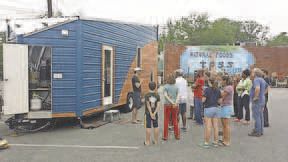Huck Fairman
Two Chicago TV personalities, a former pianist and an actress, Corbett and Grace Lunsford, rolled into the Unitarian Universalist Congregation of Princeton’s parking lot last week, trailing their TinyLab-tiny house, their beaming newborn, and bursting with information and good cheer.
They are on a 20-city tour that will be filmed and sold for airing to the producer of “This Old House.” And like that long-lasting PBS show, the Lunsfords offer a wealth of information on how to construct or renovate a house that will be highly efficient and deliver all that a contractor promises.
First focusing on their trailer, which for now is their home, and which can be towed by their pick-up truck, Corbett and Grace offered a tour. Its dimensions must be close to those of a small New York studio apartment, and yet it doesn’t feel cramped. Every inch of its high walls and ceiling is used in providing a kitchen, shower, toilet, double-decker sleeping and/or seating space, and storage cabinets.
Constructed to be highly energy efficient with airtight insulation, and using green materials, along with built-in sensors, it requires little energy to cool, heat, or light. Moreover those systems are built to the highest performance standards and provide the cleanest air — all off-grid. An outside closet houses the controls and mechanical systems, while portable, detachable solar panels can be placed near the trailer to provide its electricity.
In a time when housing prices in many places are rising, whether buying or renting, the Lunsfords are demonstrating an affordable, efficient, sustainable, and portable alternative.
The other half of their presentation, the Building Performance Workshop, is for the benefit of people who are considering new home construction or home improvement. The Lunsfords’ goal is to help them choose the best, most efficient options for their home. And step No. 1 is to help homeowners understand that their houses are systems, not a collection of independent parts. The good news is that with today’s technologies, it is now possible to test and prove house systems are, or are not, operating as advertised. “Proof is possible,” say the Lunsfords, and they urge homeowners to choose contractors who are willing to prove the installed performance levels of the systems they sell.
From their own 2008 experience, the Lunsfords learned that house construction can be “messy” and often does not quite go or perform as promised. In 2009, they started teaching contractors, through their new Building Performance Workshop, how to offer better service. The first step was for the contractors to admit they did not know, or have the time to learn, all that they should.
Coming out of their workshop experience, the Lunsfords have produced over 100 YouTube videos and 75 interviews for their Building Performance podcasts. In addition, Corbett has written a book: “Home Performance Diagnostics – The Guide to Advanced Testing.” And he developed a software testing tool to go with it.
Their experience has enabled them to offer a helpful summary, available in their brochure, Proof Is Possible, of the four essential home performance categories: Heat Flow, where drafts, discomfort, and high energy bills indicate a problem; Air Flow and Pressure, where warm air and cool air do not mix and doors slam when the AC turns on; Moisture, which damages or destroys walls, floors, or ceilings and can produce health problems and odors; Air Quality, a health hazard, often found in crawl spaces and near combustion appliances; sometimes revealed by mold or mildew.
The solutions to these potential problems all require control. And generally that calls for air sealing, insulation, and/or systems upgrades. But to have a clear picture of where a building was, before improvements, and where it is, following improvements, demands performance testing.
Therefore, a contractor should discuss with a client measurable goals and then be able to document improvements in airtightness, temperature consistency, moisture and humidity, forced air flows, and equipment performance. (Demonstrations of testing these categories are available at: http://YouTube.com/c/HomePerformance )
In order to get a house operating the way a home owner and contractor want it to requires that its systems be carefully designed, that all components are selected for performance, and finally, that installations are tested to see if they work as planned.
In addition to evaluating these steps, both the owner and contractor need to understand how much cooling, heating, and lighting a house really needs. The risks are buying a system that is too big or powerful, or too small. Those are decisions which a contractor should be expected to explain and plan for.
Another important factor to consider is providing for ventilation and fresh air. The Lunsfords point out that a house can never be too tight, but some provision (such as an energy/heat recovery ventilator) should be made to exchange trapped air for fresh air.
The Lunsfords also alert both owners and contractors to the challenges found in different parts and components of a house. These include attics, side attics, and crawl spaces, which if not adequately insulated can leak heat and cooling. Walls can do the same. Pipes and ducts must also be evaluated for the same issues. Basements must be designed, or renovated to deal with moisture, water, and combustion appliances (and the gases they can emit.) They should also be well insulated at the foundation level as well as inside.
Thus there are a number of evaluations to be made in order to construct or renovate an efficient, healthy, and economical home. The Building Performance Workshop, available online, can provide much of the necessary information.
The Lunsfords, above all, urge prospective buyers or renovators to educate themselves and find a contractor who will adapt his recommendations to their building’s individual needs, and then be willing to test the results. For as the Lunsfords remind us: Proof of performance is now possible.
Huck Fairman is a Princeton author who writes SOLUTIONS about environmental issues.

